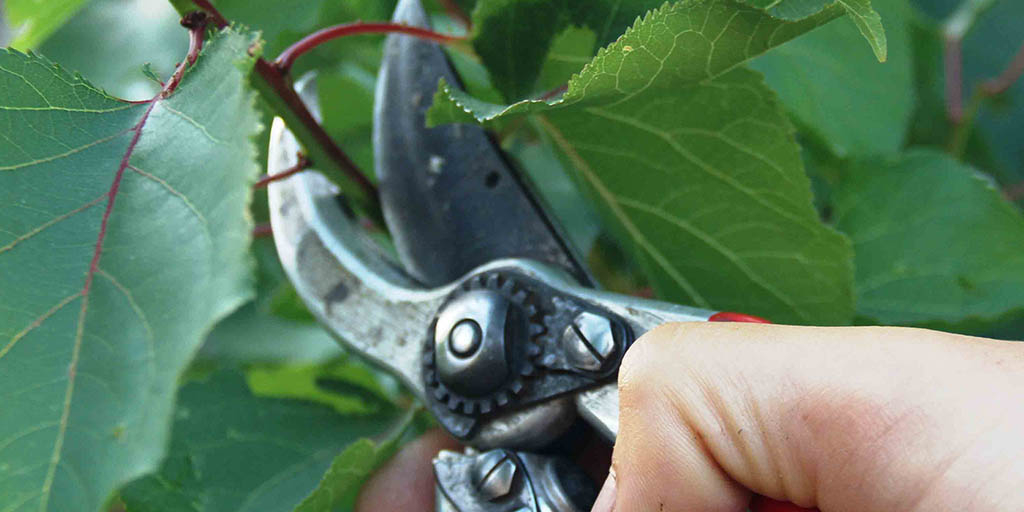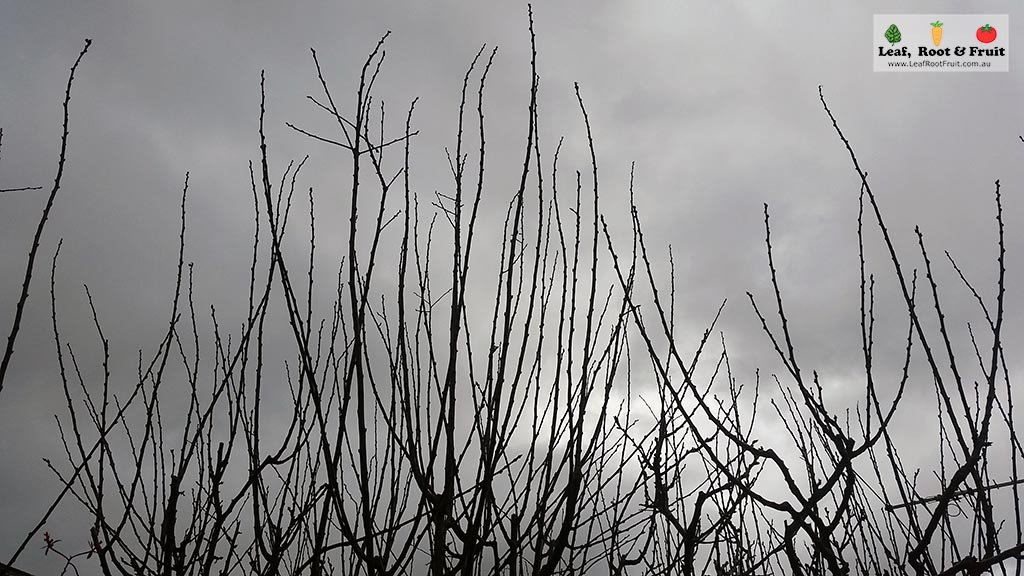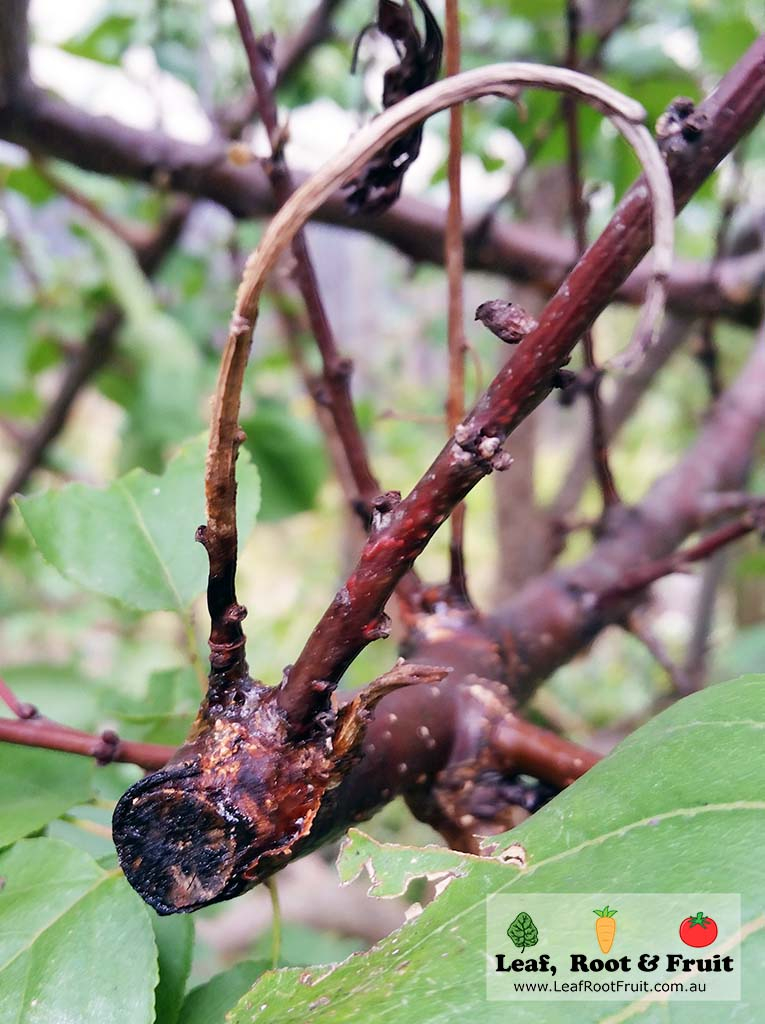
Neglecting to prune your fruit trees won’t stop production of fruit. However, it can help to establish a strong framework of branches to support heavy fruit loads.
Pruning fruit trees can result in larger fruit that is easier to harvest. The tree may be much tidier and takes up less space in the garden. However, using dwarfing rootstocks may negate the need for any fruit tree pruning in the first place. Other trees, such as young apple and pear espaliers may need pruning several ties per year to keep them neat and tidy.
We’ve put together this quick guide for when you should be pruning your trees.
Winter vs Summer Pruning of Deciduous Fruit Trees
Winter pruning of fruit trees usually results in vigorous growth. The harder the fruit tree is pruned in winter the more vigorous the growth will be in spring. Winter pruning is used to train a tree to a particular shape or to encourage substantial growth. Winter pruning is recommended for newly planted trees up until the tree has achieved the desired height and shape.
In general, summer fruit tree pruning retards growth.The already established framework is maintained. The new growth that follows is tamed and is much less vigorous than growth following winter pruning. This allows more energy to be put into fruit. Once a system of summer pruning is established, very little winter pruning of the framework is required

Timing of Pruning to Avoid Disease
The timing of your fruit tree pruning is vital to prevent introduction of disease. This is especially the case for cherries and apricots.
Fruit trees are best pruned when they are actively growing. This enables them to heal wounds faster. Avoid pruning susceptible trees (e.g. apricot or cherry) on cold or humid days, and never when there is a strong chance of rain.
All deciduous trees go through an annual cycle. They break dormancy in spring, when the sap flows from the trunk and branches, out to the growing tips and puts on new growth. The tree continues to grow through summer until autumn. During autumn the sap flow reverses and is drawn back into the tree.
If you prune a tree in autumn, the reversed sap flow will draw any pathogens introduced at the cut, down into the trunk. It will help diseases spread. Never prune susceptible fruit trees during this time. If the leaves have started to change colour, then it is best not to prune susceptible trees. More resilient trees such as plums, apples and pears are less of an issue to prune in autumn, although it’s best to wait until winter.
From a prevention of disease perspective, the best time to prune an apricot or cherry is when it is actively growing in spring or summer. I would avoid pruning Apricots and Cherries in autumn or winter.

When to Prune Deciduous Fruit Trees
The only fruit trees which require a defined pruning period are apricots which should be pruned only when the trees are actively growing (eg spring or summer)
Winter pruning time for other fruit trees is from autumn, when the tree is beginning to lose its leaves, through to spring,as the flowers are beginning to open.
Summer fruit tree pruning can be carried out before or after harvest. ‘Summer pruning’ may even be carried out in autumn!
Remember: Winter pruning promotes vigorous growth; summer pruning inhibits growth.
Winter
- Winter prune young deciduous fruit trees such as apple, pear (always lightly), peach, nectarine and plums.
- Autumn-fruiting raspberries (primocanes) should be cut back in late winter to within a few centimetres of the ground. Newly planted raspberries and hybrid blackberries should also be pruned.
- Pruning blueberry bushes should be performed after harvest has finished, ideally in winter.
Spring
- Pruning citrus trees by removing diseased or dead wood. Citrus trees are tip bearers so I usually prune them with hedge trimmers.
- Thin some small fruits on early-season stone (apricots, plum and peach) and pome (apple and pear) fruit trees to improve the quality and size of the remaining fruit.
- Passionfruit vines can be pruned in mid- to late spring.
Summer
- Continue thinning small fruit on late-season deciduous fruit varieties into the early part of summer.
- Carry out summer pruning on deciduous fruit trees after harvesting in late summer.
Autumn
- Summer pruning of deciduous pome and stone fruit trees should be completed by early autumn.
- Shoots of blackberry hybrids that have fruited should be cut down.
- Cut out summer-fruiting raspberry canes (floricanes) that have completely finished fruiting.
Other
- Bananas (yes, you can even grow some varieties of Bananas in Melbourne) are cut to the ground after fruiting. Each plant will be replaced by an emerging sucker.
- Avocados are pruned lightly immediately after harvest. Trim only one side or the top of the tree annually. Rotate the part that you trim each year to maximise fruit production.
Want Pruning Reminders Sent Directly To Your Inbox?
Sign up to our monthly newsletter:
- A guide on what to plant in your garden in the upcoming month
- What’s happening in our garden and other gardens across Melbourne
- Upcoming gardening events
- Hints and tips on gardening


Pingback: Plum-tree tidy – gardenjargon
I have some fruit trees in my yard. I’ve noticed that they aren’t giving very good fruit. I didn’t know that pruning was so important! I’ll make sure to keep them pruned based on the season.
Hi Braden,
Pruning (or not pruning) can be very important for ensuring that fruit trees are productive long-term. Glad you liked the article.
Good Luck and Happy Gardening!
Duncan
Hello I have a peach tree,I live in Melbourne,can I prune it now in summer
Hi John,
Yes you can prune your peach tree at any time of the year. The only time that I would avoid pruning the tree is in Autumn when the sap is flowing from the leaves back into the trunk. If you cut the tree when this is occurring – any pathogens such as fungi and bacteria will be drawn down from the wound and into the trunk of the tree.
Kind Regards
Duncan
Hi Duncan
I have an apricot tree that is getting too high and wide can I cut it back now and how do I go about it?
It bore its first really good crop of fruit 2 years ago, last year it bore no fruit, could this be because it needs to cross pollinate as our other apricot tree died.
Thanks
Cherie
Hi Cherie,
It’s probably a bit late in the season to be pruning apricots. I’d prefer to see them pruned back in February. This will reduce the risk of disease.
Poor pollination is not the likely cause as most apricots are self-fertile. The lack of fruit could be several reasons:
– poor growing conditions (drought, wind) that leads to abortion of immature fruit
– biennial cropping brought on by the tree producing too much fruit the year previous. This can be prevented with thinning of fruit to ensure the tree has a lighter crop.
Without knowing more details it would be difficult to pin-point the exact cause.
Good Luck and Happy Gardening!
Duncan
I’m a little confused… in the article you state “The only fruit trees which require a defined pruning period are apricots which should be pruned very early in the dormant season as soon as the leaves turn yellow, around late March early April.”
Yet above states “I’d prefer to see them pruned back in February. This will reduce the risk of disease.”
Can you please explain this discrepancy?
Thanks for pointing that error out Robert. I’ve updated the article to make it clearer.
Good Luck & Happy Gardening!
Duncan
This is great information. Does it apply to ornamental fruit trees too, such weeping cherry? And I have a fruiting weeping mulberry that needs a haircut. And finally does the principle also apply to non-fruit trees such as a Melia?
Hi Julia, this advice definitely applies to ornamental varieties such as weeping cherry. There may be other factors influencing pruning of non-fruit trees, but in theory this advice could help guide decision making.
Good Luck & Happy Gardening!
Hi Duncan,
My espaliered pears(2 different varieties) are about 7 or 8 years old and are yet to produce fruit. I prune in summer. No blossom has been produced this year but i have a lot of ‘whippy branches’ of about coming off the laterals of about 60 cm. Should i cut them back?
Your advice is appreciated.
Cheers
John
Hi John,
Without seeing the trees it’s very difficult to give you advice.
Most pears are spur bearers. So you need to encourage these to develop off your lateral branches. Spurs generally form on older, slower growing wood. You could try pruning your whippy branches back to around 5 to 10 cm. Hopefully that well help to develop spurs. Pears can take a bit longer than say apples or stone fruit to start producing, although after 7 or 8 years you would definitely expect to be getting some fruit. We’ve got pear espaliers that are 3 years old and are already producing. I suspect that you have trees on a vigorous rootstock, that may also be part of the problem.
Good Luck and Happy Gardening!
Duncan
I have two two year old Japanese Plum trees. They produced just a few plums this summer. I didn’t expect too many so that’s ok.
Should I prune them now or wait until winter. It seems that people have different views about this.
Hi Jack,
Yes, you’ll get many different views on fruit tree pruning. There’s an old joke in our industry “you can have 5 people standing around a fruit tree and 8 different opinions on how to prune it”!
Without seeing the tree it’s hard to recommend when and how to prune it. You can prune at any time of the year. The general advice is, if it has grown to the size and has the structure that you want then prune in summer (usually once you have harvested fruit). If the tree still needs to grow bigger, then winter pruning is best until it gets to the size and shape that you want.
Good Luck and Happy Gardening!
Duncan
Hi! My cheeky sheep got into my orchard a couple of weeks ago and ate the leaves off the small branches and have broken some of the branches on my fruit trees. Should I prune them back?
Thanks
Hi Jess,
Fruit trees are generally quite resilient and will handle a bit of browsing by larger animals. That being said, tidying up the damage into nice clean cuts with secateurs could speed up healing and reduce the potential introduction of disease.
Good Luck and Happy Gardening!
Duncan
i have a 40 year old plum tree and it has not been pruned for 25 years. how severe should i cut it back
Hi Chris,
Pruning the tree very hard, is going to result in a lot of rampant growth next summer. Especially if you prune it now, in winter. I’d be inclined to not take more than 10 to 20% of the tree off at a time.
You may be interested in our upcoming fruit tree pruning class on 28/07/18 as it will cover this in detail. Tickets can be purchased here: https://www.eventbrite.com.au/e/winter-fruit-tree-care-and-pruning-masterclass-tickets-46055217395?aff=efbeventtix
Good Luck and Happy Gardening!
Duncan
Need a quote to prune a peach tree 5-7yrs old. Location Lynbrook small 450sq mtr block .Easy access please ring .
Mobile 0413252322.
Hi, we have a very old and very large lemon tree (with abundant, giant fruit… and also abundant and giant wasp galls) growing close to our house. We are planning to renovate – probably at the end of this year or the beginning of next year. While we will ask the builders to take care, the renovations will have quite a big impact on the tree given how close it is. What can we do to maximise its chance of survival? Should we prune it back? If so, when?
Thanks for your help,
Cheers,
Inger
Hi Inger,
Without seeing the tree and the plan for the works it is difficult to give you accurate advice. Citrus trees have a shallow, fibrous root system. So I would take measures to try and reduce soil compaction around the tree. If the root system is likely to be damaged, then yes, cutting it back can help it survive. However, that can have other consequences, such as a rapid burst of growth in the months after pruning. If the build is likely to occur during hot weather and you wont be living in the house, then keep in mind that the builders may not be paying much attention to the garden. So perhaps best to visit regularly and give the tree a good watering.
Good Luck with the project
Duncan
Hi
My Pear tree makes a lot of growth every year & only about a dozen fruits. I have budded two other varieties onto the tree to assist with polination. My problem is the consistant amount of growth it puts on. Do you have any ideas on how to reduce the growth & create fruit.
Cheers
Noel
Hi Noel,
That’s complex and a bit difficult to answer in this thread, but I’ll try anyway!
Firstly having the tree on a dwarfing rootstock such as Quince A will reduce a lot of the vigour. Avoid high nitrogen fertilizers. Focus on pruning the tree in summer as this reduces the vigours growth that occurs after pruning. In fact the less pruning you can do the better.
The other important thing to do with multigrafted trees is to match the vigour of all the varieties. For instance including a vigourous variety such as Packham will see the tree quickly be dominated by that variety. In such cases you have to do a lot of pruning to keep the tree under control.
Hope that helps. Perhaps keep an eye out for one of our pruning workshops in the future. Then I can explain it in much more detail and show you some pruning strategies.
Good Luck & Happy Gardening
Duncan
good advices
I have summerpruned the pear and plumtree and now the tres have blossoms here and there.Have I pruned too early ?
Hi Ria,
That’s nothing to worry about. It’s quite common for fruit trees in Melbourne to do this. The fruit usually amounts to nothing, so best removed form the tree.
Good Luck & Happy Gardening!
Duncan
I have summerpruned the pear and plumtree and now the trees have blossoms here and there.Have I pruned too early ?
Hi Ria,
That’s quite common at this time of the year and is probably not related to the pruning you did. The blossoms don;t amount to much, but nothing to worry about.
Good Luck & Happy Gardening.
Duncan
I have a couple of older apple trees in the yard that we bought a few years ago and while I have trees back to being manageable I’m amazed at the ‘canes’ the shoot up from both trees. Is this normal for apple trees?
Hi Ken,
That’s completely normal, especially for trees pruned in winter. Essentially you’ve unbalanced the tree by pruning, so that it has more roots and leaves. The tree responds by trying to balance itself again… by growing lots more foliage. The best way to reduce the impact of this is to do summer pruning. Usually straight after you’ve picked the fruit. Alternatively, grow dwarf fruit trees that don’t need much (if any) pruning at all.
Hope that’s useful!
Duncan
Hopefully the pruning guide will improve my fruit trees
We hope so too Thomas!
I have a five year old pomegranate here in Melbourne. Last year was its best season with 36 fruit. Unfortunately the possums ripped through my netting and ate/destroyed 34 of the fruit. I then did a hard early Winter prune to make the tree height more manageable and also a light early Spring prune to remove and crossover branching. This season there is only 1 pomegranate growing. What is the best time to prune? And how do you protect your pomegranates?
Hi Kerrie,
Possums don’t usually chew through netting. Rats are usually the culprits that do that. We protect our pomegranates with netting to keep the birds away but don’t tend to suffer marauding possums and rats. We have a blog post on controlling possums that you may find useful.
Prune your tree in winter, but as little as possible. Heavy prunes will reduce yields, as you have discovered.
Good Luck & Happy Gardening
When best to prune olives?
Hi Bo,
Olives can be pruned after the fruit has been picked or during winter.
Good Luck & Happy Gardening!
I’d like to move some established fruit trees 6 years old +
Any tips and should I Prune them first?
In our experience you are probably better off starting from scratch with some bare-rooted fruit trees on quality root stocks.
Good luck with the move if you decide to give it a shot anyway!
Hi,
I live in North Eastern Victoria on a large property. I have apricots, granny smith apple, orange, lemon, walnut, cherry and plum trees. All of these trees (with the exception of the apple) are older trees that have been severely neglected over the years. The trees are overgrown but are still producing fruit. I would like to prune them all back and cover with netting as we have cockatoos, galahs, king parrots and possums getting to our fruit before they are ready to harvest. The branches on our lemon trees have been breaking with the weight of the fruit and the heavy winds (we live in a valley).
My question Is, when and how is the best way to cut these trees back to promote healthy growth and keep the wildlife off of our harvest for next year?
Hi Renee,
Most of the apples and stone fruit are best summer pruned. So pretty much straight after picking the fruit. If you prune in winter you will cause a large growth of foliage in the form of water shoots. Citrus tend to be best pruned in late spring.
Hope that helps
Duncan
I pruned back a 3 year old plum in early autumn. I now am worried it was too early. I live in the New England area of NSW. More West though.
Will it be OK? It is a Japanese plum.
Hi Erica,
The plum tree itself will be fine. They are resilient trees. However, pruning in late autumn is essentially a winter prune. So it will likely result in a huge flush of new growth. Summer pruning tends to promote the production of fruit, rather than leaves.
Good Luck & Happy Gardening
Duncan
Hi
Is it too late to prune European and Japanese plums in Taradale?
Thanks
Hi Jenny,
Plums can be pruned at any time of the year… however, there are consequences… Plums are pretty resilient so you don’t need to worry about disease so much. Pruning them in winter is likely to result in a huge flush of vegetative growth. I feel that they are better pruned as soon as the fruit has been picked, ie summer pruned.
Hope that helps
Duncan
Thanks for the offer regular pruning reminder is excellent
Glad you find it useful Megan
Happy Gardening!